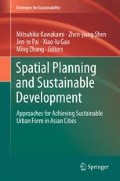Abstract
In the era of the knowledge economy, knowledge comprises the core of economic growth, making the exploration of the spatial organization of knowledge generation an important issue. This study clarifies the knowledge generation process. In terms of the development mode, the Taiwanese bicycle industry can be geographically divided into northern, central, and southern regions. Each area possesses its own independent system with related and cooperative factories. Dajia, located in central Taiwan, is the most mature of the three. The geographical closeness of and industrial cooperation between community structures allow them to share resources, reduce deal prices, and promote professional investment. Even social networks can be exploited to produce and promote creativity. Therefore, this investigation proposed utilizing knowledge groups to understand spatial organizational style, with particular reference to villages. The study results demonstrate that the knowledge activities conducted in Dajia bicycle village are determined by the composition of the village, cooperation within the industry, and effective support from industrial and social resources.
Access this chapter
Tax calculation will be finalised at checkout
Purchases are for personal use only
Notes
- 1.
Bicycle production is a traditional industry which requires creative designs and research. For example, a large factory cannot survive by making bicycles alone; it needs to undertake research and develop related products, such as electrical bikes and leisure bikes. When they face a shortage of technical know-how, their multiproduct operations encounter difficulties. Furthermore, without new batches of professionals to help raise the quality of overall performance, the quality of the workforce as a whole comes into question. This is also an important task for bicycle industry.
- 2.
The Taichung Science Park attracts most of the July and August graduates every year. Graduates make Science Park their priority when hunting for jobs after leaving school. Those who choose to join traditional industries such as bicycle production are few and far between.
References
Baptista R, Swann P (1998) Do firms in clusters innovate more? Res Policy 27:525–540
Bell ERJ (1993) Some current issues in technology transfer and academic-industrial relations: a review. Technol Anal Strateg Manag 5(3):307–321
Boschma RA (2005) Proximity and innovation: a critical assessment. Reg Stud 39(1):61–74
Breschi S (2000) The geography of innovation: a cross-sector analysis. Reg Stud 34(3):213–229
Camagni RP (1995) The concept of innovative milieu and its relevance for public policies in European lagging regions. Pap Reg Sci 74(4):317–340
Chang HL, Chang HW (2009) Exploring recreational cyclists’ environmental preferences and satisfaction: experimental study in Hsinchu technopolis. Environ Plan B Plan Des 36:319–335
Chuang WS (2005) A study on the competitive factors of bicycle industrial cluster in Dajia area. Master’s thesis, National Taiwan University
Cowan R, Hultén S (1996) Escaping lock-in: the case of the electric vehicle. Technol Forecast Soc Chang 53:61–79
Feldman MP (1994) Technological infrastructure. In: Feldman MP (ed) The geography of innovation. Kluwer, Dordrecht, pp 51–75
Hu T-S, Lin C-Y, Chang S-L (2005) Role of interaction between technological communities and industrial clustering in innovative activity: a case of Hsinchu district, Taiwan. Urban Stud 42(7):1139–1160
Isaksen A, Aslesen HW (2001) Oslo: in what way an innovative city. Eur Plan Stud 9(7):871–887
Malmberg A (1997) Industrial geography: location and learning. Prog Hum Geogr 21(4):573–582
Malmberg A, Maskell P (2002) The elusive concept of localization economies: towards a knowledge-based theory of spatial clustering. Environ Plan A 34:429–449
Massey D, Quintas P, Wield D (1992) High tech fantasies: science parks in society, science and space. Routledge, London
Monck CSP, Porter RB, Quintas P, Wynarczyk P (1988) Science parks and the growth of high technology firms. Croom Helm, London
Oakey RP (1985) High-technology industry and agglomeration economies. In: Hall P, Markusen A (eds) Silicon landscapes. ALLEN & UMWIN, Boston
Porter ME (1990) The competitive advantage of nations. Macmillan, London/Basingstoke
Ritsila JJ (1999) Regional differences in environments for enterprises. Entrep Reg Dev 11(3):187–202
Saxenian A (1994) Regional advantage: culture and competition in Silicon Valley and Route 128. Harvard University Press, Boston
Storper M (1995) Competitiveness policy options: the technology-regions connection. Growth Chang 26:285–308
Torre A, Gilly JP (2000) On the analytical dimension of proximity dynamics. Reg Stud 34:169–180
Torre A, Rallet S (2005) Proximity and localization. Reg Stud 39(1):47–59
Westhead P, Batstone S (1998) Independent technology-based firms: the perceived benefits of a science park location. Urban Stud 35(12):2197–2219
Wu JH, Chen HS (2001) A study on innovation diffusion and spatial interaction of firms in the industrial zones firms of Taiwan. Sun Yat-Sen Manag Rev 9(2):179–200 (in Chinese)
Yigitcanlar T, Velibeyoglu K, Martinez-Fernandez C (2008) Rising knowledge cities: the role of knowledge precincts. J Knowl Manag 12(5):8–20
Author information
Authors and Affiliations
Corresponding author
Editor information
Editors and Affiliations
Rights and permissions
Copyright information
© 2013 Springer Science+Business Media Dordrecht
About this chapter
Cite this chapter
Pai, Jt., Hu, Ts. (2013). The Role of the Knowledge Community and Transmission of Knowledge: A Case of Bicycle SMEs in Taiwan. In: Kawakami, M., Shen, Zj., Pai, Jt., Gao, Xl., Zhang, M. (eds) Spatial Planning and Sustainable Development. Strategies for Sustainability. Springer, Dordrecht. https://doi.org/10.1007/978-94-007-5922-0_11
Download citation
DOI: https://doi.org/10.1007/978-94-007-5922-0_11
Published:
Publisher Name: Springer, Dordrecht
Print ISBN: 978-94-007-5921-3
Online ISBN: 978-94-007-5922-0
eBook Packages: Earth and Environmental ScienceEarth and Environmental Science (R0)

